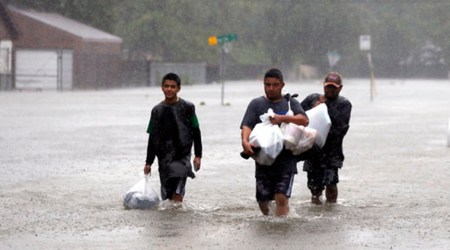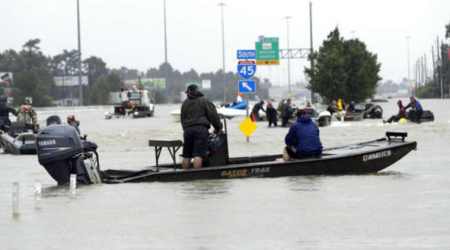 Floodwaters from the San Jacinto River inundate condominiums in the aftermath of Tropical Storm Harvey on Wednesday, Aug. 30, 2017, in Kingwood. (Brett Coomer/Houston Chronicle via AP)
Floodwaters from the San Jacinto River inundate condominiums in the aftermath of Tropical Storm Harvey on Wednesday, Aug. 30, 2017, in Kingwood. (Brett Coomer/Houston Chronicle via AP)
Tropical Storm Harvey inflicted more damage on the heart of the US energy industry on Wednesday, churning into Louisiana after flooding the biggest US refinery in Texas, causing major fuel pipelines to Midwest and East Coast markets to suspend operations and threatening to squeeze supplies across the country for weeks.
Benchmark US gasoline prices and margins surged to two-year highs as Colonial Pipeline, the biggest US fuel system, said it would shut its main lines to the Northeast by Thursday due to outages at its pumping points and lack of supplies from refiners.
At least two East Coast refineries have already run out of gasoline for immediate delivery as they scrambled to fill barges to markets typically supplied by the Gulf Coast, two refinery sources said. Others were seen operating at higher rates in order to boost profitability by meeting supply shortages.
The Explorer Pipeline, which has a capacity of 660,000 barrels a day (bpd), said it shut its main fuel line from Houston to Tulsa, Oklahoma as supplies dwindled.
Refinery damage from Harvey has driven gasoline futures prices up nearly 20 percent over the past week, and prices at the pump are rising too, particularly in the US South. More refineries could close now that Harvey has made landfall in Louisiana, where refiners can produce 3.3 million barrels per day.
The Gulf accounts for nearly half of total US refining capacity. As the United States is the world’s largest net exporter of refined petroleum products, effects of the disaster are starting to ripple through global flows.
Traders in Europe and Asia were working to reroute cargoes to the United States and Latin America to fill the gap left by refining and shipping closures in the Gulf.
The outages and limited supplies have hit wholesalers. The premium for Chicago-area gasoline above benchmark futures is at the highest since June 2016, while the Gulf Coast price is at its widest above futures since August 2012.
About 4.4 million barrels of US refining capacity have been shut by Harvey, based on company reports and Reuters estimates. That is about 24 percent of US refining capacity and almost equal to the national daily consumption of Japan.
That includes the biggest US refinery, Motiva’s Port Arthur facility, which can handle more than 600,000 barrels a day. Portions of the refinery were flooded after more than a foot of rain dropped overnight.
Other Port Arthur refineries also shut overnight, including Total’s plant, where sources familiar with operations said they expected water to recede by the weekend.
“The refineries shut down as a precaution might be able to restart. The others in a worst-case scenario could take weeks and months to repair,” said Antoine Halff, director of Global Oil Markets at the Center on Global Energy Policy at Columbia University.
More rain fell on the area in the last 24 hours than any other part of the region since the storm began last week, according to David Roth, meteorologist at the US Weather Prediction Center.
The coast took a step forward and a step back on Wednesday. Refiners further south on the Texas coast, including Marathon’s Galveston Bay, were beginning restarts, while Citgo’s 425,000 bpd Lake Charles refinery, on the Louisiana coast in the path of the storm, cut capacity in half.
DANGEROUS RESTARTS
Restarts after a storm are especially dangerous for refiners, though the Corpus Christi area received much less rain than the Houston metro area.
“The continued increase in flooding creates high uncertainty on the amount of damage that U.S. refineries will incur, the pace at which the shutdown will reverse and the magnitude of capacity that will be impaired over the next few months,” Goldman Sachs analysts wrote in a note.
They added that they would expect about 10 percent of what is currently offline would stay shut for several months.
Just last week, refiners pushed output to their highest percentage of capacity since 2005 as gasoline demand hit an all-time weekly record of 9.85 million barrels, according to US Energy Department data on Wednesday.
Gasoline futures gained 7 percent on Wednesday alone. Refinery shutdowns and fuel shortage worries have also boosted retail fuel prices, particularly in the US South and Southwest.
Overnight, the AAA said retail gasoline prices were up 6 cents from a week ago at $2.404 per gallon of regular gasoline nationwide. Some states, like Georgia, have seen prices rise as much as 12 cents a gallon. In addition, shale production has been sharply curtailed in the Eagle Ford region of Texas due to the storm.

